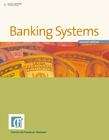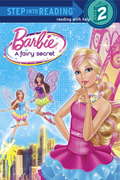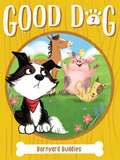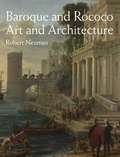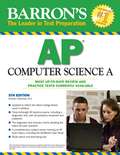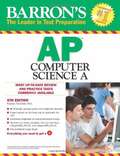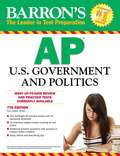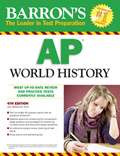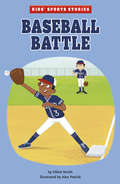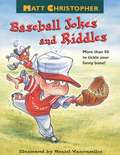- Table View
- List View
Banking General Awareness Review 5
by Xavier’s Resource Centre for the Visually ChallengedRBI circulars and IBA procedural guidelines on inclusive banking have established a strong basis for Inclusive Banking for Blind and Low Vision customers.
Banking General Awareness Review 6
by Xavier’s Resource Centre for the Visually ChallengedRBI circulars and IBA procedural guidelines on inclusive banking have established a strong basis for Inclusive Banking for Blind and Low Vision customers.
Banking Systems
by Center for Financial TrainingGet started on the fast track today. BANKING SYSTEMS 2E lets you explore the principles and practices of banking and credit in the United States through learning by doing and clear explanations. Whether it's financial services, human resources, marketing, or ethics, BANKING SYSTEMS 2E makes concepts easy to understand. Success tomorrow starts today with BANKING SYSTEMS 2E.
Bankvyavsayachi Multatve-1 First Semester FYB.COM New NEP Syllabus - SPPU: बँकव्यवसायाची मूलतत्त्वे-१ प्रथम सत्र एफ.वाय.बी.कॉम नवीन एन.इ.पी. अभ्यासक्रम - सावित्रीबाई फुले पुणे यूनिवर्सिटी
by Dr D. G. Ushir Dr S. R. Javale Dr R. K. Datir Dr S. V. Patil‘बँकव्यवसायाची मूलतत्त्वे-1’ हे पुस्तक बँकिंगच्या संकल्पना, त्याचा इतिहास, कार्ये आणि महत्त्व यावर आधारित आहे. बँकेच्या व्याख्या, प्रकार, भारतीय बँक प्रणालीची रचना, तसेच बँकिंग प्रक्रियेतील नियम आणि तत्त्वे सविस्तर समजावण्यात आली आहेत. पुस्तकात राष्ट्रीयीकृत, सहकारी, खाजगी आणि परकीय बँकांच्या कामकाजावर चर्चा आहे. तसेच ठेवींच्या प्रकार, कर्ज देण्याच्या प्रक्रिया, चलनक्षम दस्तऐवजांचे महत्त्व, वसुलीचे तत्त्व आणि बँक ताळेबंद यांवर प्रकाश टाकण्यात आला आहे. विद्यार्थ्यांना बँकिंग क्षेत्रातील बदलते तंत्रज्ञान, नव्या संकल्पना व व्यावसायिक दृष्टिकोन समजण्यासाठी हे पुस्तक उपयुक्त ठरते. 'राष्ट्रीय शैक्षणिक धोरण 2020' नुसार तयार करण्यात आलेले अभ्यासक्रम हे आधुनिक काळातील बँकिंग क्षेत्रातील गरजांसाठी विद्यार्थ्यांना तयार करते. बँकिंगमुळे आर्थिक स्थैर्य व राष्ट्रीय विकासाला चालना मिळते, हे पुस्तकाचे मुख्य गृहीत आहे.
Bansuri - Textbook of Arts class 4 - NCERT-25
by National Council of Educational Research and TrainingBansuri: Textbook of Arts for Grade 4 is an engaging and interdisciplinary arts education textbook that introduces students to Visual Arts, Music, Theatre, and Dance through interactive activities and a unifying narrative based on the Panchatantra story "The Hare and the Lion." Aligned with the National Education Policy 2020 and the NCF-SE 2023, the book encourages creativity, self-expression, collaboration, and cultural appreciation. Designed with a hands-on, story-based approach, it nurtures students’ imagination and emotional intelligence while fostering critical thinking and inclusivity in a joyful, pressure-free learning environment.
Bansuri class 4 - NCERT - 25: बाँसुरी ४थीं कक्षा - एनसीईआरटी - २५
by Rashtriy Shaikshik Anusandhan Aur Prashikshan Parishadकक्षा 4 की हिंदी पाठ्यपुस्तक बाँसुरी राष्ट्रीय शिक्षा नीति 2020 और राष्ट्रीय पाठ्यचर्या रूपरेखा 2023 के अनुसार तैयार की गई है। इस पुस्तक में विद्यार्थियों की भाषा दक्षता, कल्पनाशक्ति, संवेदनशीलता और नैतिक मूल्यों के विकास पर विशेष ध्यान दिया गया है। इसमें कविता, कहानी, संस्मरण, संवाद और लोककथाओं के माध्यम से भाषा सीखने की प्रक्रिया को रोचक और आनंदमय बनाया गया है। बालसुलभ कथाओं और प्रसंगों द्वारा विद्यार्थियों में पर्यावरण चेतना, सहयोग, अनुशासन, परिश्रम और मानवीय मूल्यों की भावना जाग्रत की गई है। साथ ही, इसमें विभिन्न अभ्यास, प्रश्नोत्तरी, समूहगत गतिविधियाँ और सृजनात्मक कार्य दिए गए हैं, जिनसे बच्चों की पठन, लेखन और मौखिक अभिव्यक्ति की क्षमता बढ़ती है। बहुभाषिक और बहुसांस्कृतिक दृष्टिकोण अपनाकर यह पुस्तक बच्चों को भारतीय समाज, संस्कृति और परंपराओं से जोड़ती है। इस प्रकार बाँसुरी विद्यार्थियों के सर्वांगीण विकास और आनंदपूर्ण अधिगम का माध्यम बनती है।
Bansuri-1 (Konkani language) class 3 - NCERT-25: बांसुरी-१ ३रीं यत्ता - एनसीईआरटी - २५
by Rashtriy Shaikshik Anusandhan Aur Prashikshan Parishad"बांसुरी-१" हे राष्ट्रीय शैक्षणिक संशोधन व प्रशिक्षण परिषदेने (NCERT) प्रकाशित केलेले, इयत्ता तिसरीसाठी संस्कृत भाषेतील कलेचे पाठ्यपुस्तक आहे. राष्ट्रीय शिक्षण धोरण २०२० आणि राष्ट्रीय अभ्यासक्रम आराखडा २०२३ च्या आधारावर तयार केलेले हे पुस्तक कलेच्या चार प्रमुख क्षेत्रांना—दृश्यकला, संगीत, नृत्य आणि रंगमंच—विविध उपक्रम आणि सोप्या कृतींच्या माध्यमातून सादर करते. मुलांना खेळातून चित्र काढणे, गाणी म्हणणे, नृत्य करणे आणि अभिनय करणे यांसारख्या गोष्टींशी जोडून त्यांच्या सर्जनशीलतेला आणि कल्पनाशक्तीला प्रोत्साहन देणे, हा याचा मुख्य उद्देश आहे. हे पुस्तक मुलांना भारताच्या समृद्ध सांस्कृतिक परंपरांची ओळख करून देते आणि कलेच्या माध्यमातून त्यांच्या सर्वांगीण विकासावर भर देते.
Bansuri-1 (Marathi language) class 3 - NCERT-25: बांसुरी-१ ३रीं इयत्ता - एनसीईआरटी - २५
by Rashtriy Shaikshik Anusandhan Aur Prashikshan Parishad"बांसुरी-१" हे राष्ट्रीय शैक्षणिक संशोधन व प्रशिक्षण परिषदेने (NCERT) प्रकाशित केलेले, इयत्ता तिसरीसाठी संस्कृत भाषेतील कलेचे पाठ्यपुस्तक आहे. राष्ट्रीय शिक्षण धोरण २०२० आणि राष्ट्रीय अभ्यासक्रम आराखडा २०२३ च्या आधारावर तयार केलेले हे पुस्तक कलेच्या चार प्रमुख क्षेत्रांना—दृश्यकला, संगीत, नृत्य आणि रंगमंच—विविध उपक्रम आणि सोप्या कृतींच्या माध्यमातून सादर करते. मुलांना खेळातून चित्र काढणे, गाणी म्हणणे, नृत्य करणे आणि अभिनय करणे यांसारख्या गोष्टींशी जोडून त्यांच्या सर्जनशीलतेला आणि कल्पनाशक्तीला प्रोत्साहन देणे, हा याचा मुख्य उद्देश आहे. हे पुस्तक मुलांना भारताच्या समृद्ध सांस्कृतिक परंपरांची ओळख करून देते आणि कलेच्या माध्यमातून त्यांच्या सर्वांगीण विकासावर भर देते.
Bansuri-1 (Sanskrit language) class 3 - NCERT - 25: बांसुरी-१ ३रीं कक्षा - एनसीईआरटी - २५
by Rashtriy Shaikshik Anusandhan Aur Prashikshan Parishad"बांसुरी-1" राष्ट्रीय शैक्षिक अनुसंधान और प्रशिक्षण परिषद् (NCERT) द्वारा प्रकाशित कक्षा 3 के लिए संस्कृत भाषा में कला की एक पाठ्यपुस्तक है। राष्ट्रीय शिक्षा नीति 2020 और राष्ट्रीय पाठ्यचर्या की रूपरेखा 2023 के आधार पर तैयार की गई यह पुस्तक कला के चार प्रमुख क्षेत्रों—दृश्यकला, संगीत, नृत्य और रंगमंच—को विभिन्न गतिविधियों और सरल क्रियाकलापों के माध्यम से प्रस्तुत करती है। इसका उद्देश्य बच्चों को खेल-खेल में चित्र बनाने, गीत गाने, नृत्य करने और अभिनय करने जैसे कार्यों से जोड़कर उनकी रचनात्मकता और कल्पनाशीलता को प्रोत्साहित करना है। यह पुस्तक भारत की समृद्ध सांस्कृतिक परंपराओं से बच्चों का परिचय कराती है और कला के माध्यम से उनके सर्वांगीण विकास पर बल देती है।
Bansuri-1 Textbook for Arts class 3 - NCERT-25
by National Council of Educational Research and Training"Bansuri–1" is an arts textbook designed for Class 3 students under the National Education Policy (NEP) 2020 and the National Curriculum Framework for School Education (NCF-SE) 2023. The book introduces children to four major art forms—Music, Visual Arts, Dance, and Theatre—through interactive activities that encourage creativity, self-expression, and cultural appreciation. It emphasizes experiential learning, allowing students to explore artistic traditions through singing, drawing, acting, and movement. The textbook incorporates inclusive classroom practices, integrates digital learning via QR codes, and encourages community participation by involving local artists and families. By fostering artistic skills, self-awareness, and an appreciation of India’s rich cultural heritage, Bansuri – I aims to develop well-rounded individuals equipped with creative and critical thinking abilities.
Bansuri-1 Textbook for Arts class 3 - NCERT-25: बाँसुरी-1 कक्षा 3 कला की पाठ्यपुस्तक - एन सी ई आर टी-२५
by National Council of Educational Research and Training"बांसुरी – I" कक्षा 3 के लिए बनाया गया एक कला पाठ्यपुस्तक है, जो राष्ट्रीय शिक्षा नीति (NEP) 2020 और राष्ट्रीय पाठ्यचर्या रूपरेखा (NCF-SE) 2023 के तहत विकसित की गई है। यह पुस्तक चार प्रमुख कला रूपों—संगीत, दृश्य कला, नृत्य और रंगमंच—से बच्चों को परिचित कराती है। इसमें इंटरैक्टिव गतिविधियों के माध्यम से रचनात्मकता, आत्म-अभिव्यक्ति और सांस्कृतिक समझ को बढ़ावा दिया गया है। पाठ्यपुस्तक अनुभवात्मक शिक्षण पर बल देती है, जिससे छात्र गायन, चित्रकारी, अभिनय और शारीरिक गतिविधियों के माध्यम से कलात्मक परंपराओं की खोज कर सकें। यह समावेशी कक्षा पद्धतियों को अपनाती है, डिजिटल शिक्षा को क्यूआर कोड के माध्यम से एकीकृत करती है, और स्थानीय कलाकारों व परिवारों की भागीदारी को प्रोत्साहित करती है। बांसुरी – I न केवल कलात्मक कौशल विकसित करने में सहायक है, बल्कि यह आत्म-जागरूकता और भारत की समृद्ध सांस्कृतिक विरासत की सराहना करने की भावना भी जागृत करती है, जिससे बच्चे रचनात्मक और आलोचनात्मक सोचने की क्षमता से सुसज्जित हो सकें।
Barbie: A Fairy Secret (Barbie)
by Christy WebsterIn Barbie's latest direct-to-DVD movie, Barbie discovers that there are fairies living all around us! But when Ken gets kidnapped by an evil fairy, Barbie and her friends must travel to the enchanted fairy world and save him. Barbie(TM): A Fairy Secret promises to be Barbie's most successful movie ever! Girls will love this exciting new Step 2 reader based on Barbie's latest release.From the Trade Paperback edition.
Bark, Barkley, Bark! (Fountas & Pinnell Classroom, Guided Reading)
by Michelle Barbera Missy PanicoNIMAC-sourced textbook
Barnyard Buddies (Good Dog #7)
by Cam HigginsIn this irresistible seventh book of the Good Dog series, Bo doesn&’t want to miss any of the barnyard fun!Bo loves having lots of friends on the farm. There&’s always something to do and a barnyard buddy to play with. Bo doesn&’t want to lose out on a single second with any of them, but he can&’t be in two places at once! With easy-to-read language and illustrations on almost every page, the Good Dog chapter books are perfect for emerging readers.
Baroque And Rococo Art And Architecture
by Robert NeumanBaroque and Rococo Art and Architecture is the first in-depth history of one of the great periods of Western art, spanning the years 1585 to 1785. The text treats the major media—painting, sculpture, drawings, prints, and architecture—as well as gardens, furniture, tapestries, costume, jewelry, and ceramics, all in terms of their original function and patronage and with emphasis on the social, political and cultural context. Organized by country and medium, the book contains biographies of the leading creative figures of the time, from Caravaggio and Rembrandt to Watteau and Hogarth. Significantly, Professor Neuman offers the fullest account to date of women artists and the representation of women and families in art. Additionally, drawing from recent scholarship, the text explores such fields as Spanish polychrome sculpture and Viceregal American painting. <p><p> Baroque and Rococo Art and Architecture reviews traditional and recent strategies for interpreting artworks. It also traces the dissemination of visual ideas through prints and drawings—the forerunners of today's art reproductions and digital media. In special sections the text raises questions regarding the nature of perception and how artists transfer optical data to the canvas. Artists' techniques, from painting and printmaking to sculpting in marble and casting in bronze, are explained. Analysis of the institutions of art, such as the royal academies, apprenticeship systems, and artists' exhibition rooms, complements an examination of collecting at all levels of society. The book is exceptional in considering issues related to authenticity and the relative value of artworks based on attribution. <p> The illustrations comprise a visual resource of unprecedented quality, with some 450 images reproduced in full color and in a large format that ensures high detail and emphasizes recent conservation efforts. Finally, an extensive glossary introduces seventeenth- and eighteenth-century art terms.
Barron's AP Computer Science A (5th Edition)
by Roselyn TeukolskyThis best-selling review manual has been thoroughly updated to reflect the College Board's elimination of the Level AB course and the updated Level A syllabus. The new edition presents three full-length AP practice exams for the Level A course. The first exam is a diagnostic test and contains charts detailing the topics for each question. All three model tests have questions answered and explained. Test takers will also find an extensive subject review including new sections on static variables, the List interface, Integer. MAX_VALUE, and Integer. MIN_VALUE. A section on two-dimensional arrays is included for the Level A exam.
Barron's AP Computer Science A (6th Edition)
by Roselyn TeukolskyThe updated test prep manual presents computer science test takers with-- Three full-length AP practice tests for the Level A course, including a diagnostic test Charts detailing the topics for each test question All test questions answered and explained Test takers will also find an extensive subject review including sections on static variables, the List interface, Integer. MAX_VALUE, and Integer. MIN_VALUE. The practice exams contain several new questions on two-dimensional arrays and also reflect the new free-response style used on the 2012 AP exam.
Barron's AP U.S. Government and Politics
by Curt Lader M.A.The Advanced Placement U.S. Government and Politics course and test, unlike the other Social Studies AP courses and tests, is contemporary in nature. In-depth preparation for the AP U. S. Government and Politics exam features: Two full-length model AP exams with answer keys and explanations An extensive subject review covering Constitutional development, the branches of federal government, political parties, special interest groups, the media, bureaucracy, and public policy issues related to the economy, the federal budget, social welfare, foreign policy and national defense Newly revised end-of-chapter multiple-choice and free-response questions with rubrics for each.
Barron's AP World History (Fourth Edition)
by John MccannonThis newly updated manual presents two full-length model AP World History exams with answer keys, plus detailed advice on answering the comparative essay question, and helpful strategies for answering the test's multiple-choice and document-based questions. An extensive subject review covers the following general areas: Foundations of World Civilization (8000 B. C. -1000 A. D. ) World Cultures Maturing (1000-1450) World Cultures Interacting (1450-1750) World Cultures in the Modern Era (1750-1914) The 20th Century and Contemporary World Cultures (1914-2009)
Baseball Battle (Kids' Sports Stories)
by Elliott SmithLifelong friends Jackson and Logan are moving up from T-ball to baseball, and they couldn't be more excited. But when both boys want to play first base, it's a baseball battle! It's up to these young athletes to decide which is more important: sports or friendship.
Baseball Jokes and Riddles: More than 50 to tickle your funny bone!
by Matt Christopher Daniel VasconcellosA collection of wacky jokes, riddles, puns, and anecdotes about America's favorite pastime is gathered by a favorite young sports fiction writer and is guaranteed to liven up locker rooms and baseball diamonds alike.

